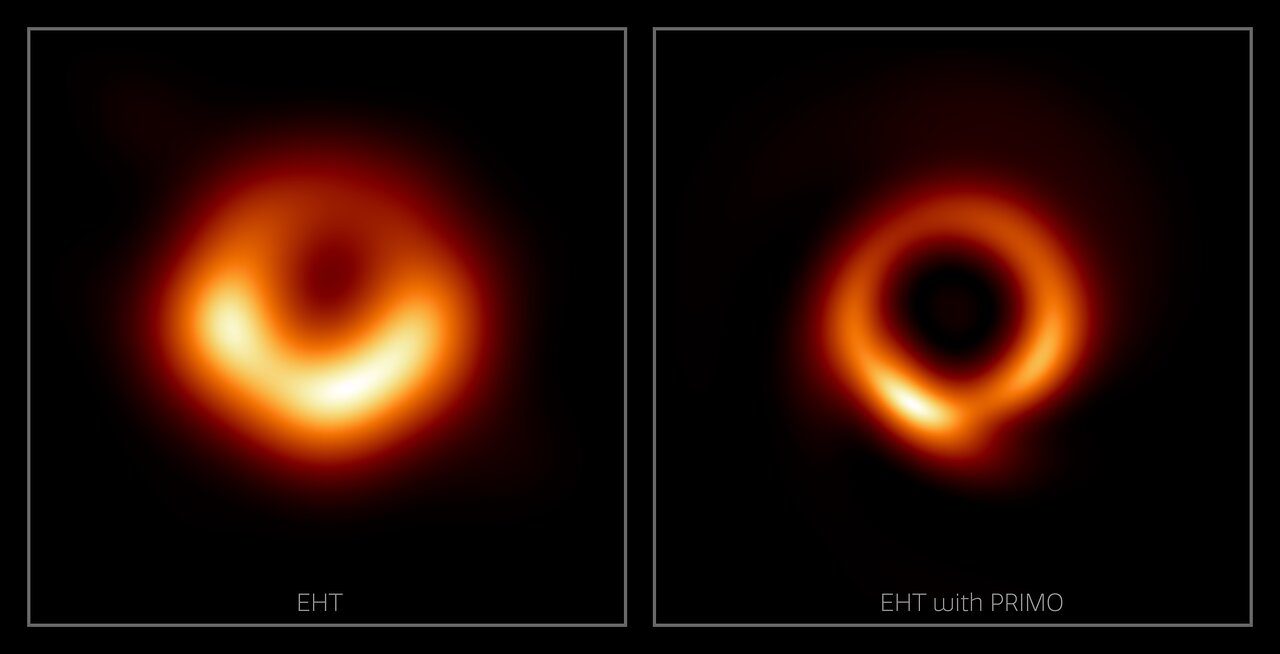In April 2019, astronomers revealed one of humanity’s greatest achievements in science – the first-ever image of a black hole. (Of course, the photo wasn’t directly of the black hole itself, that would be impossible. More on that later.) Now, thanks to a new machine-learning technique that has sharpened the image, a new version has been released and M87* has never looked better.
Since that first historic release, we’ve also had the first image of our own supermassive black hole, Sagittarius A*, which sits at the center of the Milky Way, but when Messier 87 had the treatment in 2019, to the casual observer who may not have known what to expect, it was a bit… blurry.
This new image, given an AI makeover, better shows the dark central region of the object and the unexpectedly narrow bright ring of emission from the hot gas falling into the black hole. The researchers involved are keen to stress this isn’t using AI to fill in the gaps, like some smartphones do to boost their camera’s image capabilities, but rather using the original data from the Event Horizon Telescope (EHT) collaboration and running it through their newly developed program to actually represent the full resolution of the EHT.
“With our new machine-learning technique, PRIMO, we were able to achieve the maximum resolution of the current array,” says lead author Lia Medeiros, an original member of the EHT collaboration, in a statement.
“Since we cannot study black holes up close, the detail in an image plays a critical role in our ability to understand its behavior. The width of the ring in the image is now smaller by about a factor of two, which will be a powerful constraint for our theoretical models and tests of gravity.”
But let’s start at the beginning. Back in April 2017, the EHT collaboration turned seven radio telescopes around the globe to look in the same direction, the idea being it would create one Earth-sized telescope. Their goal was an ambitious one: to image the shadow of the event horizon of a supermassive black hole, which they did. Before that first image, the only way to look at a black hole was indirectly, observing its effects rather than the object itself. Black holes are objects that generate a field of gravity so strong that nothing in its vicinity – including light – can escape.
Right on the edge of that precipice is the event horizon (the central edge of the orange ring, the accretion disk), the threshold where to escape the pull of the black hole you’d need to move faster than the speed of light – and according to Einstein’s theory of special relativity, nothing in space can move faster than the speed of light. It’s the shadow of the event horizon of M87* that astronomers managed to photograph.
Fast forward to now, and some members of the EHT have developed what they are calling PRIMO (principal-component interferometric modeling), which relies on dictionary learning – where AI is taught “rules” by exposing it to thousands of examples. Applying PRIMO to the EHT’s M87* data analyzed 30,000 high-fidelity simulated images of the event horizon to find common patterns in the images. Blending the results created a much sharper – and still highly accurate – representation of the EHT’s observations, which also managed to estimate some of the missing data from the original image.
Comparison of M87* from the original EHT data and reconstructed with PRIMO. Image credit: L. Medeiros (Institute for Advanced Study), D. Psaltis (Georgia Tech), T. Lauer (NSF’s NOIRLab), and F. Ozel (Georgia Tech)
The team has also confirmed that the new image is consistent with both the original data and the theoretical expectations of what M87* is like. Using this new technique could lead to more accurate measurements of its mass and other behaviors. Sagittarius A* may even be next.
“The 2019 image was just the beginning,” said Medeiros. “If a picture is worth a thousand words, the data underlying that image have many more stories to tell. PRIMO will continue to be a critical tool in extracting such insights.”
The study is published in The Astrophysical Journal.
Source Link: First-Ever Image Of Black Hole Has Been Sharpened By AI And It’s Incredible
